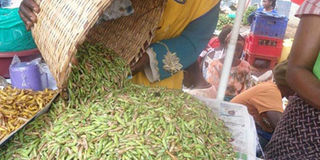Scientists to breed grasshoppers all year-round

The delicious insects have a higher fat content than soybeans at 18.6 per cent and avocado at 12 per cent, which are some of the commonly consumed high fat plant foods in Uganda. FILE PHOTO
What you need to know:
- Speaking at the same workshop, Ms Gertrude Ngabirano, the Executive Secretary of EASTECO, said they have a mandate to develop a regional innovation led bio-economy strategy for East African countries.
- She further revealed that the East African block is the first regional block in the whole of Africa to come up with this bio economy strategy.
Kampala. November is well known as the month for grasshoppers, popularly known as nsenene, in central and south-western Uganda.
However, the wait for November will soon be no more as scientists will now breed the grasshoppers throughout the year.
The project is expected to supplement diets and reduce protein, energy and micronutrient deficiency among people.
The project is led by Dr Dorothy Nakimbugwe of Makerere University and is being carried out by scientists from the East African Science and Technology Commission (EASTECO).
“The nsenene comes once in a year in the month of November but our teams have come up with new innovations of growing it all year round so that we don’t wait for that one month. We should be eating the complement ones as we wait for the Masaka ones,” Mr Julius Ecuru, the programme manager of BioInnovate Africa, revealed on Saturday during a two-day workshop in Kampala.
When asked when the first locally reared nsenene will be available, Mr Ecuru said by 2020/21.
Mr Ecuru further said they have injected about $15m into supporting East African scientists for the next four to five years to help them transfer their ideas into practice.
According to the website of BioInnovate Africa (www.bioinnovate-africa.org), the need to rear nsenene throughout the year was due to the high demand exerted on the animal proteins which are not enough.
“It’s estimated that 827 million people in developing regions, most of them in Africa, suffer undernourishment and the situation is expected to worsen, unless efforts are made to reverse food and nutrition insecurity.
Alternative food
“Protein-rich edible insects are increasingly being viewed as viable and sustainable alternatives to animal and plant proteins,” the website states
At 41-43 per cent, the fat content in grass hoppers is high and is comparable to edible oil seeds such as pumpkin seeds at 41 per cent and groundnuts at about 49 per cent.
The delicious insects have a higher fat content than soybeans at 18.6 per cent and avocado at 12 per cent, which are some of the commonly consumed high fat plant foods in Uganda.
The grasshopper meal is high in unsaturated fatty acids with omega 9 being the predominant monounsaturated fatty acid, which has been associated with lower cardiovascular disease risk.
Speaking at the same workshop, Ms Gertrude Ngabirano, the Executive Secretary of EASTECO, said they have a mandate to develop a regional innovation led bio-economy strategy for East African countries.
She further revealed that the East African block is the first regional block in the whole of Africa to come up with this bio economy strategy.




